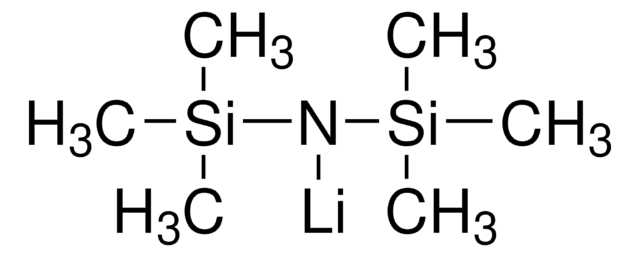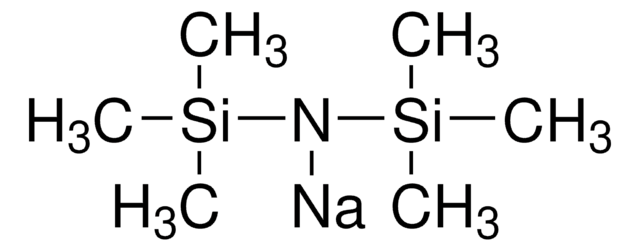Key Documents
775053
Lithium bis(trimethylsilyl)amide solution
0.5 M in 2-methyltetrahydrofuran
Synonim(y):
Hexamethyldisilazane lithium salt
About This Item
Polecane produkty
Postać
liquid
Poziom jakości
charakterystyka ekologicznej alternatywy
Safer Solvents and Auxiliaries
Use of Renewable Feedstocks
Inherently Safer Chemistry for Accident Prevention
Learn more about the Principles of Green Chemistry.
sustainability
Greener Alternative Product
stężenie
0.5 M in 2-methyltetrahydrofuran
gęstość
0.857 g/mL at 25 °C
kategoria ekologicznej alternatywy
ciąg SMILES
[Li]N([Si](C)(C)C)[Si](C)(C)C
InChI
1S/C6H18NSi2.Li/c1-8(2,3)7-9(4,5)6;/h1-6H3;/q-1;+1
Klucz InChI
YNESATAKKCNGOF-UHFFFAOYSA-N
Szukasz podobnych produktów? Odwiedź Przewodnik dotyczący porównywania produktów
Opis ogólny
Zastosowanie
2-Methyltetrahydrofuran (2-MeTHF): A Biomass-Derived Solvent with Broad Application in Organic Chemistry
Opakowanie
Informacje prawne
Hasło ostrzegawcze
Danger
Zwroty wskazujące rodzaj zagrożenia
Zwroty wskazujące środki ostrożności
Klasyfikacja zagrożeń
Acute Tox. 4 Oral - Eye Dam. 1 - Flam. Liq. 2 - Self-heat. 1 - Skin Corr. 1B
Zagrożenia dodatkowe
Kod klasy składowania
4.2 - Pyrophoric and self-heating hazardous materials
Klasa zagrożenia wodnego (WGK)
WGK 2
Temperatura zapłonu (°F)
8.6 °F
Temperatura zapłonu (°C)
-13 °C
Wybierz jedną z najnowszych wersji:
Masz już ten produkt?
Dokumenty związane z niedawno zakupionymi produktami zostały zamieszczone w Bibliotece dokumentów.
Nasz zespół naukowców ma doświadczenie we wszystkich obszarach badań, w tym w naukach przyrodniczych, materiałoznawstwie, syntezie chemicznej, chromatografii, analityce i wielu innych dziedzinach.
Skontaktuj się z zespołem ds. pomocy technicznej





